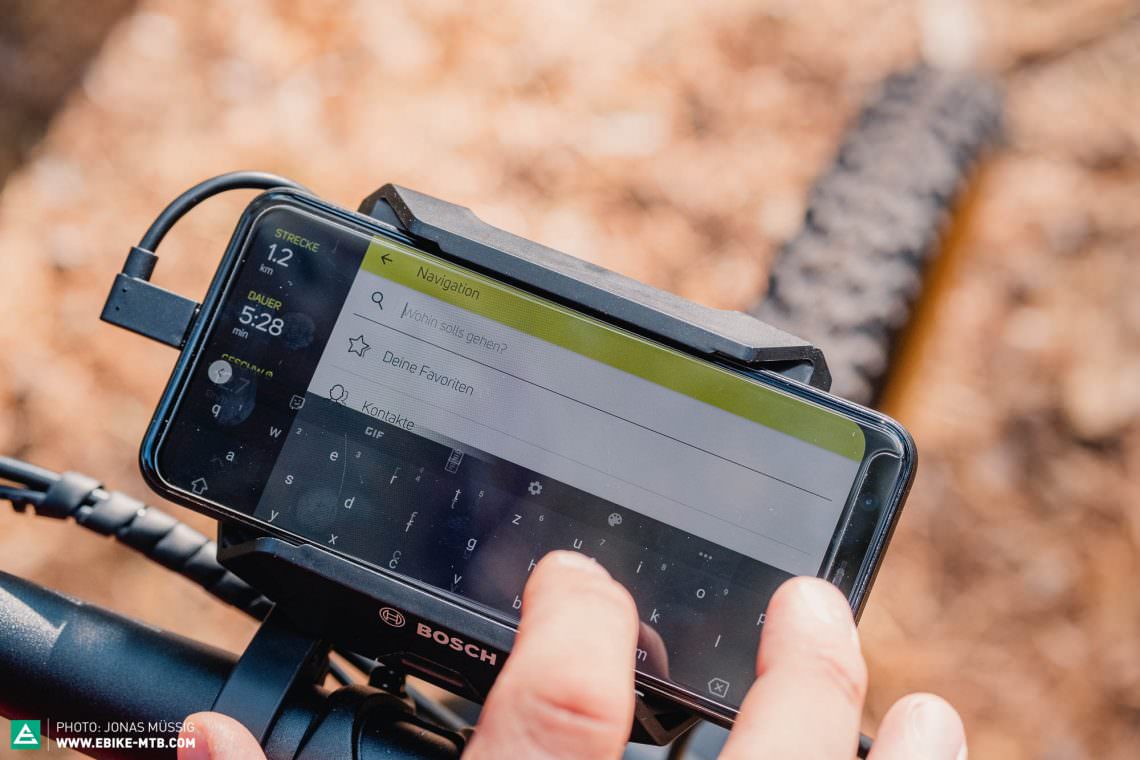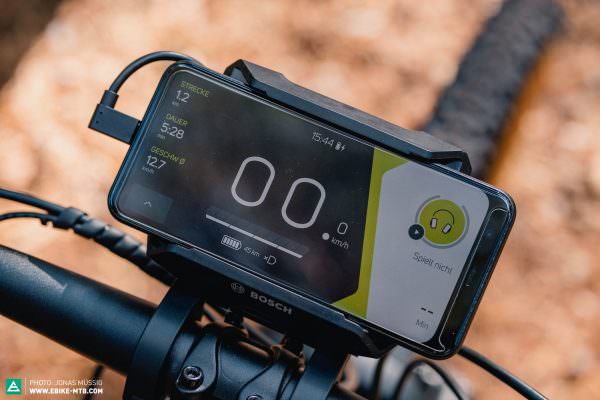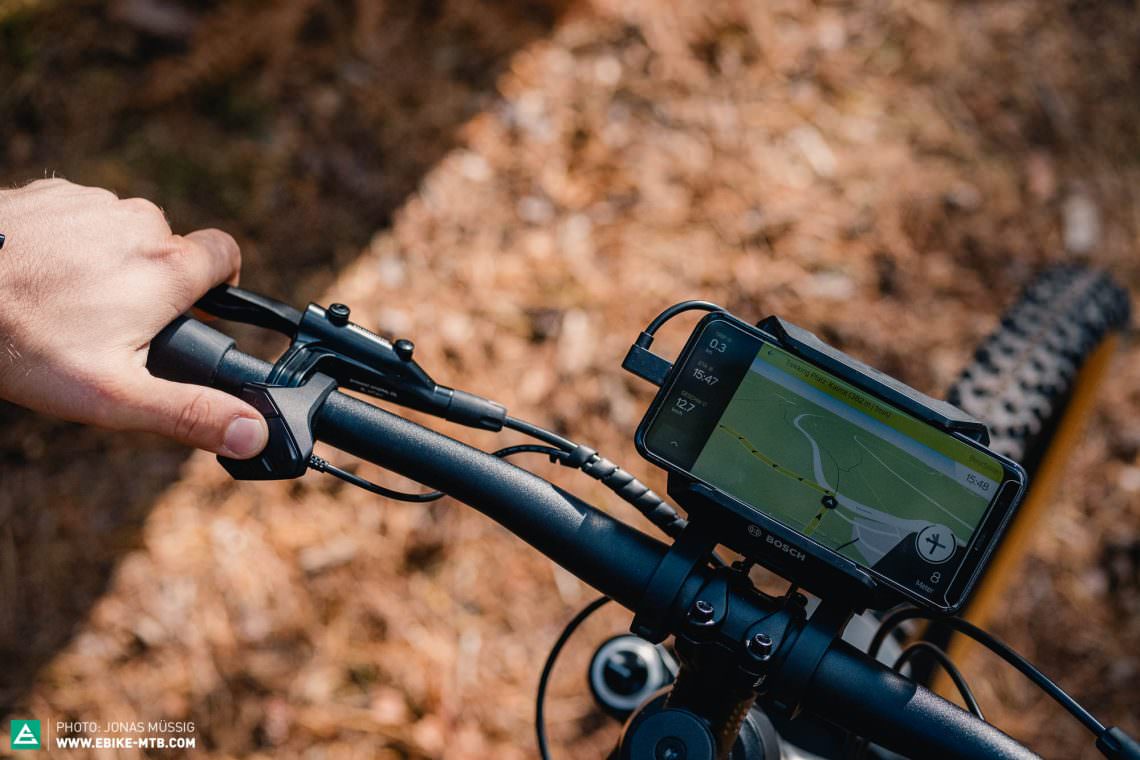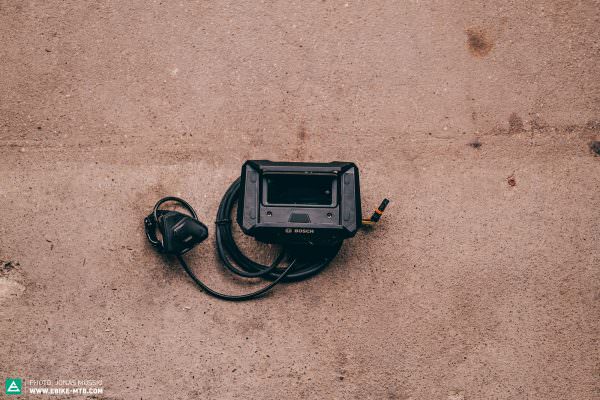The Bosch SmartphoneHub turns your smartphone into your ebike’s command centre, adding GPS navigation and additional functionality. On its own, it’s a minimalistic ebike display for the most crucial riding data. Are smartphones the better navigation devices? Our group test has the answer.
Click here for an overview of the best e-bike navigation device

197 g including clamp (without smartphone)| € 229 | Manufacturer website
Miss the point. Navigation with the Bosch SmartphoneHub hardly goes beyond the functionality of Google Maps. The SmartphoneHub is attractive because of its convenient additional features
The Bosch SmartphoneHub features an integrated 1.5″ mini display. It shows your battery level, speed, support mode and range. This rudimentary display is sufficient for short rides but the SmartphoneHub is capable of so much more. Combined with your smartphone, its character changes completely, turning it into an intelligent control centre. Ride data is transmitted from the mini display to the large screen of your smartphone via Bluetooth connection, with the COBI.Bike app acting as the interface. You can use either a spring-loaded clamp or a special smartphone case to attach your phone to the SmartphoneHub. You can also charge your smartphone on the SmartphoneHub while riding. As an aftermarket solution, the Bosch SmartphoneHub costs € 230. Similar to the Bosch Nyon, you should also budget for the cost of installation at your local dealer.

Commands from the remote on the handlebar are directed to the smartphone. That way you can use the remote to navigate the menu of the COBI.Bike app. One of these menu items is the integrated navigation. Anyone familiar with Google Maps will quickly get to grips with the COBI.Bike app. Enter the desired destination in the search bar or scroll across the map until you’ve found your desired destination, then simply press and hold to mark it. The navigation system allows you to choose between the fastest, shortest or quietest route. If you select the quietest route, the GPS device will try to avoid main roads. Unfortunately, the map view lacks vital topographical information about the routes, which is why you could unknowingly embark on a sufferfest of climbs. The navigation function also lacks the option of setting personal preferences, such as including trails in the calculation of routes. Apart from switching between 2D and 3D and being able to zoom, the map view and other displays can’t be customised and, unfortunately, you can’t see the battery level whilst you’re in it. The competition offers better solutions in this regard.



The navigation function compares the battery range of the selected support mode with the distance to the destination and displays a red marker to indicate when the destination is out of range. The software quickly responds to detours and is flexible in redirecting the route. While riding, you even have the option of activating voice output, which announces upcoming turns like the GPS in a car. Depending on your smartphone and GPS accuracy, you may occasionally miss a turn, which is partly due to turning instructions being given too late. This is where the better GPS devices set themselves apart from the competition. If you want to plan more complex routes with intermediate stops, you can only do so via Bosch’s eBike Connect platform or connected third-party apps such as Komoot and Strava. If you want to avoid using up all of your mobile data, you can download global maps onto your smartphone for offline use. When you remove your smartphone from the bracket and turn it upright, navigation pauses. Unfortunately, this also means that the app sometimes misinterprets aggressive riding manoeuvres as the rider stopping and taking the phone out of the bracket, which couldn’t be further from the truth.


The COBI.Bike app has fitness features that track your cadence, power output and calorie consumption, as well as data from connected devices such as a heart rate monitor. You can also control the music player on your smartphone, look at the weather forecast and call the contacts in your phone book without having to take your hand off the handlebar. The premium Help Connect package offers an additional crash detection feature. If you crash, it automatically starts a countdown and unless you stop it, the app sends out an emergency call with your location.
Conclusion
The Bosch SmartphoneHub is a clever idea, allowing you to use your phone as a GPS navigation device and bringing an intelligent smartphone bracket to the ebike market. However, the navigation function of the COBI.Bike app has some weaknesses and cannot keep up with the best of the test field. For those who want to use their smartphone as a navigation device when commuting, in everyday life and on paved paths, the SmartphoneHub offers a cost-effective upgrade for bikes with the Purion or Intuvia display at just under € 230.
Tops
- easy to use
- voice output
- can be used without a smartphone
Flops
- navigation is slow at times
- no elevation profile
- no customisation options
- for Bosch systems only
Get more information here: bosch-ebike.com.
The Testfeld
Get a quick overview of this test here: The best e-bike navigation device
All navigation devices in the group test: Bosch COBI.Bike Sport (Click for review)| Bosch Nyon (Click for review) |Bosch SmartphoneHub | Garmin Edge 1030 Plus (Click for review) | SIGMA ROX 12.0 (Click for review)
Did you enjoy this article? If so, we would be stoked if you decide to support us with a monthly contribution. By becoming a supporter of E-MOUNTAINBIKE, you will help secure a sustainable future for high-quality cycling journalism. Click here to learn more.
Words: Rudolf Fischer Photos: Jonas Müssig









